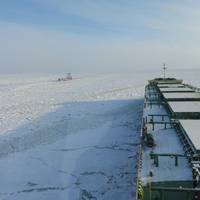Classification Society BV Sharpens Ice Tools

Bureau Veritas has responded to demand for safe LNG transportation in the Arctic regions by developing new high-level tools to assess cargo sloshing in ice conditions. It has also developed a cutting-edge probabilistic method for assessing ice loads on structure which will reduce the time and data needed to assess the structure of vessels and units designed for heavy ice operation. Pierre Besse, Director of Innovation, Bureau Veritas, says, “All eyes are on the Arctic sea routes and on the opening up of the Arctic mineral and energy resources.
Bureau Veritas Sharpens Ice Tools
International classification society Bureau Veritas has responded to demand for safe LNG transportation in the Arctic regions by developing new high-level tools to assess cargo sloshing in ice conditions. It has also developed a cutting-edge probabilistic method for assessing ice loads on structure which will reduce the time and data needed to assess the structure of vessels and units designed for heavy ice operation. Pierre Besse, Director of Innovation, Bureau Veritas, said, “All eyes are on the Arctic sea routes and on the opening up of the Arctic mineral and energy resources. We have to ensure the vessels and offshore units that operate in those extreme conditions are safe.
BV, Russian Register Sign Agreement
Bureau Veritas (BV) and Russian Maritime Register of Shipping (RS) signed a three-year co-operation agreement covering the development of joint guidelines for LNG carriers and Offshore Floating Production Units (FPUs). Pierre Besse, Vice-President Research and Development for BV, says, “We are delighted to have reached this agreement with RS, which will greatly facilitate research into two technologically challenges areas of shipping. The agreement is based on the exchange of information for the mutual benefit of BV and RS, and for the maritime industry generally. "We will now be able to combine the particular strengths of the BV and RS rules, to produce definitive guidelines which draw on the experience and expertise of both organizations. Dr.
Bureau Veritas, Brazilian University Speeds Deepwater Development
International classification society Bureau Veritas has agreed a technical co-operation deal with COPPE/UFRJ, the Ocean Engineering department of the Universidade Federal do Rio de Janeiro, to set up a joint development centre. The move builds on co-operation agreements with nineteen universities in China, Russia, Korea, Singapore, Malaysia, Vietnam, Australia, Taiwan and France and is intended to speed the development of tools and technical requirements needed to facilitate Brazil’s expansion into deep offshore oil exploitation. Pierre Besse, Vice-President Research and Development for Bureau Veritas said, “We will initially have four people working full time on the Rio university development group…
BV Backs High-Speed Craft Safety Design Tool
Bureau Veritas (BV) has backed a new tool designed to enhance the safety and cost-effectiveness of high-speed craft. Dubbed the Safety at Speed (S@S) tool, the product was developed by a consortium of 15 companies backed by EU research funding. "This S@S design tool will help designers, class societies, yards and government authorities to evaluate high-speed craft at an early design stage, improving safety and cost-effectiveness," said Pierre Besse, research director of Bureau Veritas. The intent is to extend and customize the product for other ship types. The aims of the EU-funded S@S project were to develop new design tools and methodologies that would raise the profile of safety issues at the very beginning of the design process.
Investment in Design: New Solutions for LNG Tankers
With its bid for commercial marine power applications strengthened by the addition of the MT30 aeroderivative gas turbine to its range, Rolls-Royce is pushing the concept of gas turbo-electric powering in the buoyant LNG carrier market. gas turbine-based system. A saving of around 40-percent in installation man-hours is claimed by Rolls-Royce for its powering solutions using either simple cycle or combined cycle arrangements, along with significant savings in weight relative to steam turbine, dual-fuel diesel-electric and low-speed diesel alternatives, all of which have now been embraced by the LNGC sector. Capable of dual-fuel operation…







